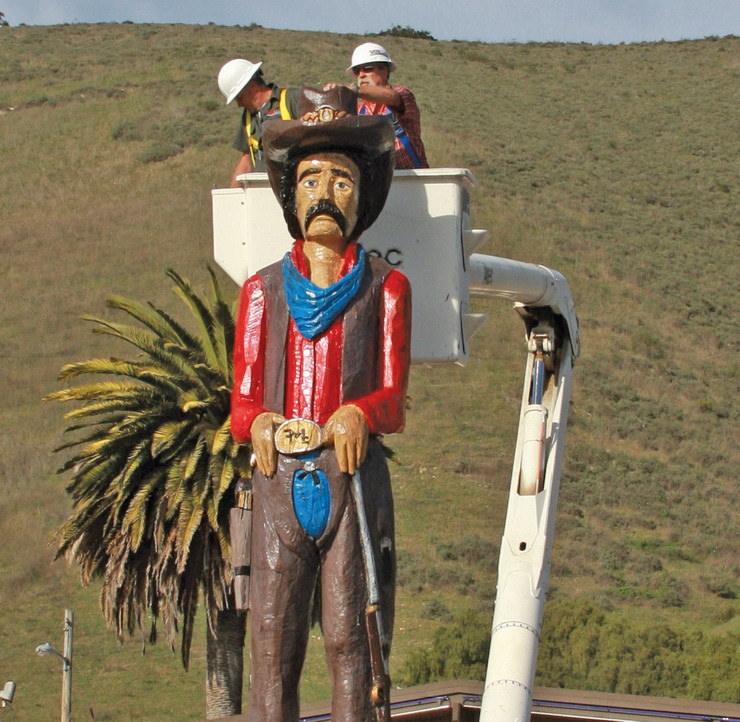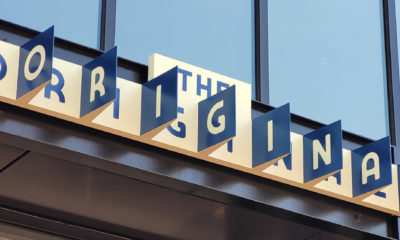Opened in 1974, F. McLintock’s Saloon and Dining House in Pismo Beach, CA, which overlooks the Pacific Ocean above Highway 101, has gained a reputation for its oak-pit-barbecued steaks, ribs and seafood. (It’s named for an owner’s friend, not John Wayne’s title character from the famous 1963 Western, George Washington McLintock.) But, it still abounds with frontier flavor, thanks to the 22-ft.-tall, carved cowboy statue that resides onsite. In 1983, Burlwood Inc.’s Eusebio Dalay, George Buck and Joe Vallaire fashioned Clint the Cowboy, based on a lamp depiction in the restaurant’s lobby.
However, after a quarter-century of helping hordes hungry for beef find the restaurant, the iconic McLintock’s cowboy began to show signs of wear. Damage from dryrot and a bark-beetle infestation forced Clint’s super-sized Stetson to be removed, and also ravaged an arm, leg and pistol.
The proprietor enlisted Mark Blackford and his shop, Signcraft (Santa Maria, CA), to restore Clint to his former glory. Rather than fabricating Clint’s new parts from wood, he opted for Coastal Enterprises (Orange, CA) 12- to 18-lb. Precision-Board® high-density urethane (HDU).
“Clint’s proximity to the beach required a more durable, stable material that’s easier to use,” Blackford said. “We were replacing the hat due to dryrot and insect damage, so we wanted to avoid those same problems in the future.”
Signcraft used 18-lb. material for the hat’s brim to provide more support, and cut lower-density HDU for the other parts. Fabricators laminated 1⁄2- to 6-in.-thick, HDU pieces together, which were joined with screws and Coastal’s PB Bond epoxy. The shop carved the components traditionally with handsaws, angle grinders, chisels, rasps and files.
After having fumigated the entire structure, Signcraft sanded it to remove loose material before sealing it with West Systems’ two-part, epoxy clearcoat. Stainless-steel rod fortified the leg’s replacement section, and similar rods were also drilled and epoxied into Clint’s head to secure the hat. Countersunk fender washers and nuts help retain it in place. Blending in the new parts with the existing statue required PB Bond and Coastal’s FSC-WB88 water-based primer/filler, as well as Bondo body filler.
Advertisement
To create the cowboy’s color, Signcraft applied an array of lettering-enamel hues – dark blue, ivory, chamois, white, medium- and dark-brown, gold, silver and black – with foam brushes for broad areas and detail brushes for narrow contours. To create an aged appearance, Signcraft thinned dark-brown enamel for a final coat.
“We were able to construct Clint’s new parts from scrap pieces in the shop,” Blackford said. “But, it was a challenge to blend the new parts to the original sculpture’s chainsaw effect, beveled shapes and cut marks.”
To complete fabrication of all of Clint’s upgrades except the hat, Signcraft used a Ford chassis-mounted, Altec 54-ft. boom truck.



 Tip Sheet2 weeks ago
Tip Sheet2 weeks ago
 Photo Gallery3 days ago
Photo Gallery3 days ago
 Ask Signs of the Times5 days ago
Ask Signs of the Times5 days ago
 Real Deal2 weeks ago
Real Deal2 weeks ago
 Paula Fargo19 hours ago
Paula Fargo19 hours ago
 Benchmarks1 week ago
Benchmarks1 week ago
 Photo Gallery20 hours ago
Photo Gallery20 hours ago
 Women in Signs2 weeks ago
Women in Signs2 weeks ago







